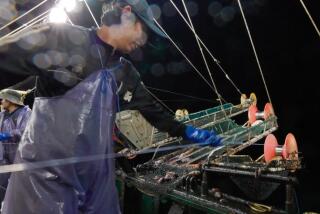Ban on Huge Fishing Vessels Sought
- Share via
SEATTLE — The brawny floating fish factories that vacuum the Gulf of Alaska and Bering Sea with their 100-ton nets have become the latest target of the environmental group Greenpeace, which charges that the U.S. fleet threatens one of the nation’s last robust fisheries.
In a campaign announced Thursday, Greenpeace officials called for a ban on the ocean-going trawlers that scoop up more than 1 million tons of fish a year off the coast of Alaska, much of it processed on board. In 1994 that resulted in the accidental catch of 580 million pounds of unwanted fish, which were thrown dead or dying overboard, Greenpeace said.
The campaign--which follows Greenpeace’s successful effort to ban drift net fishing in international waters--targets nearly 50 U.S.-flagged industrial trawlers that represent an investment of more than $1.5 billion. The bulk of the Seattle-based fleet, the largest and most efficient fishing vessels in the world, operates in the teeming waters of the North Pacific.
Industry officials attacked the campaign, arguing that the North Pacific fishery remains one of the most vibrant on Earth after 30 years of heavy fishing. They said the industry has federal monitors on each ship and is working voluntarily to reduce the number of accidentally caught fish, which they asserted is substantially below international averages.
“We are threatened by a bully, and we are extremely concerned,” said factory trawler owner John Bundy of Glacier Fish Co., flanked by several of the company’s 250 employees. “They would take our jobs, our pride, our way of life, all for a . . . more perfect social order. Greenpeace is a 900-pound gorilla, and frankly we are scared.”
In a report released Thursday, Greenpeace said that factory trawlers--with nets 2 miles around, large enough to contain a dozen jumbo jets--were responsible for depleting critical East Coast fisheries when largely foreign-owned fleets plied waters off the United States several decades ago, virtually free of control.
The U.S.-flagged fleet that mostly replaced foreign ships off the American coast operates under a significant new web of regulations. But Greenpeace believes that even the fertile waters of the North Pacific--which produce more than half the nation’s annual catch of groundfish and a quarter of the world’s pollack catch--are now threatened by the industrial-scale operations.
The organization asserts that declines in seabird and marine mammal populations in the region can be accounted for only by competition for food with commercial fishing. This has not been scientifically proven.
Moreover, Greenpeace said, factory trawlers are responsible for substantial wastes of fish, not only with the large volumes of catch of untargeted species--including salmon, halibut and crab--but with the discarding of large volumes of targeted fish deemed too small for the on-board plants.
Factory trawlers fishing for mid-water pollack dumped more than 188 million pounds of pollack deemed commercially undesirable overboard in 1994--more than the combined incidental catch of groundfish of all other groundfish boats working in Alaskan waters that year, the group said.
“What is important is not that we need to stop fishing, but in fact we need to return to a sustainable fishery, which sustains coastal fishing communities,” said Greenpeace Executive Director Barbara Dudley, noting that the factory trawlers bypass coastal fishing plants and cut into the catch of small commercial fishermen. Overall, the Seattle-based trawlers catch more than 60% of the groundfish hauled in by a fleet numbering more than 1,300 vessels, the group said.
“When they deplete one part of the world, they simply move on. They’re bound and beholden to no place on Earth, so essentially it’s a formula for depletion,” Dudley said.
Industry officials say the U.S. fleet is being blamed for the excesses committed by foreign trawlers before the new regulations, monitoring and voluntary compliance took effect. These programs, they said, have reduced incidental catch in the North Pacific to 15% of the total haul, half the international average.
That number could be improved further, they said, by adoption of a system being considered by Congress that would eliminate the rush to catch fish at the beginning of the season by allowing boats to fish at leisure to meet an individual quota.
Overall, they said, the industry harvests about a third less than what federal biologists have determined would allow continued optimal reproduction of fisheries in the North Pacific.
More to Read
Sign up for Essential California
The most important California stories and recommendations in your inbox every morning.
You may occasionally receive promotional content from the Los Angeles Times.













